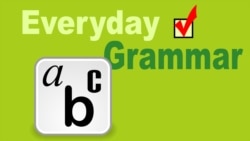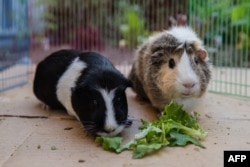Last week, we looked at two kinds of poems, the cinquain and the diamante or diamond poem. We explored parts of speech: nouns, verbs, adjectives and adverbs with poems. Many of you wrote to us and shared your poems.
In today’s Everyday Grammar, we will look at the cinquain and the haiku. But we will place our attention on the use of syllables to create the poems.
Syllables
A syllable is a natural division of a word. For example, the word, “flower” has two syllables: -flow and -er.
The number of syllables in the word depends on the number of vowel sounds. In the word "flower" there are two vowel sounds.
Although there are about 20 vowels sounds in English, all the sounds can be written with the letters a, e, i, o, u, and sometimes y.
One syllable can be written with more than one vowel letter, like in the word “boot.” Although there are two vowel letters, o and o, there is only one vowel sound -oo.
When two separate vowel sounds are next to each other in the same syllable, it is called a diphthong.
One way to identify vowel sounds is to clap your hands together when you hear the vowel sounds. Take the word “winter.” We clap our hands together twice, win-ter. If you cannot clap, you can tap your foot or tap a desk, or even count on your fingers.
Haiku poems
Haiku are short poems that are based on syllables and not do rhyme. They are a Japanese art form. But writers in many countries have copied them. In English, they are expressed in three lines, and the poem has 17 syllables throughout the three lines. They are centered on nature and two opposing ideas in a single moment in time.
In English, haiku can deal with nature, or they can be about anything, as long as the traditional structure is maintained.
Let’s look at the English form of the syllable structure for a haiku:
Line 1: Five syllables
Line 2: Seven syllables
Line 3: Five syllables
Let’s look at an example:
Sleeping guinea pigs
Eyes wide open, no true trust
Until food arrives
In the poem above, I wrote about my guinea pigs. We can see the syllable structure below:
Slee-ping gui-nea pigs (5 syllables)
Eyes wide o-pen, no true trust (7 syllables)
Un-til food ar-rives (5 syllables)
Here is another example about winter.
Still snowing in March
When will spring be on its way?
No sunshine, so sad
Let’s clap this one out.
Still snow-ing in March
When will spring be on its way?
No sun-shine, so sad
Hopefully, spring will be here soon. Let’s move on to another kind of poem that we learned about before, the cinquain.
Cinquain with syllables
Just like the cinquain from last week, the form with syllables has five lines. Each line contains an even number of syllables.
Line 1 contains two syllables.
Line 2 has four syllables.
Line 3 has six syllables.
Line 4 has eight syllables.
Line 5 contains just two syllables, like the first line.
Here is an example:
Hot days
Arrive soon now
Sun ri-ses earlier
Sun sets later in the evening
Warm nights
Now, let’s look at the syllable structure line by line.
Hot days (2 syllables)
Arr-ive soon now (4 syllables)
Sun rises ear-li-er (6 syllables)
Sun sets la-ter in the eve-ning (8 syllables)
Warm nights (2 syllables)
If you understand syllables well, you can include a rhyme or two within the cinquain poem.
Writing tips and ideas
Now, you have the structure for two kinds of poems created by using syllables, haiku and a cinquain. Haiku have three lines. All the lines add up to 17 syllables, divided up into 5-7-5. A cinquain has five lines and a total of 22 syllables. Each line has an even number of syllables, increasing by two until the last line.
Now, start brainstorming ideas for your own poem. Write about what you know. Get outside and take a walk; let nature or your surroundings inspire you.
Once you have an idea, you can jump right in with counting syllables. Or you can write your idea in a paragraph form or a list, and then fit it to the structure of either a cinquain or a haiku.
Send your poems to learningenglish@voanews.com.
Or share your poems in the comments below!
We love reading what you send! We will select a few to give feedback on next week!
I’m Faith Pirlo. And I'm Dan Novak.
Faith Pirlo wrote this lesson for VOA Learning English.
________________________________________________________________
Words in This Story
syllable – n. any one of the parts into which a word is naturally divided when it is pronounced
vowel – n. a letter (such as a, e, i, o, u, and sometimes y in English) that makes a specific sound
clap – n. to hit the palms of your hands together usually more than once
guinea pig – n. a small furry animal, or rodent, that is often kept as a pet
rhyme – n. one of two or more words or phrases that end in the same sounds
brainstorm – v. to think of many ideas
inspire –v. to get an idea about what to do or create from a person or something you see or experience
___________________________________________________________________
What do you think of this story? We want to hear from you. Write to us at learningenglish@voanews.com or leave us a comment below.
We have a new comment system. Here is how it works:
-
Write your comment in the box.
-
Under the box, you can see four images for social media accounts. They are for Disqus, Facebook, Twitter and Google.
-
Click on one image and a box appears. Enter the login for your social media account. Or you may create one on the Disqus system. It is the blue circle with “D” on it. It is free.
Each time you return to comment on the Learning English site, you can use your account and see your comments and replies to them. Our comment policy is here.












Forum